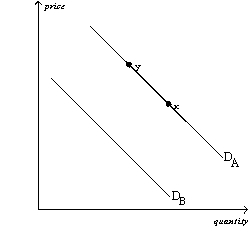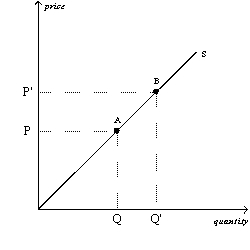Correct Answer

verified
Correct Answer
verified
Multiple Choice
Figure 4-14  -Refer to Figure 4-14.At a price of
-Refer to Figure 4-14.At a price of
A) $8,there is a surplus of 6 units.
B) $5,there is neither a shortage nor a surplus.
C) $2,there is a shortage of 6 units.
D) All of the above are correct.
Correct Answer

verified
Correct Answer
verified
Multiple Choice
If the demand for a good falls when income falls,then the good is called a(n)
A) normal good.
B) regular good.
C) luxury good.
D) inferior good.
Correct Answer

verified
Correct Answer
verified
Multiple Choice
If the supply of a product decreases,then we would expect equilibrium price
A) to increase and equilibrium quantity to decrease.
B) to decrease and equilibrium quantity to increase.
C) and equilibrium quantity to both increase.
D) and equilibrium quantity to both decrease.
Correct Answer

verified
Correct Answer
verified
Multiple Choice
Adam Smith suggested that an invisible had guides market economies.In this analogy,what is the baton that the invisible hand uses to conduct the economic orchestra?
A) the government
B) prices
C) subsidies
D) the Federal Reserve
Correct Answer

verified
Correct Answer
verified
Multiple Choice
If a decrease in income increases the demand for a good,then the good is a(n)
A) substitute good.
B) complementary good.
C) normal good.
D) inferior good.
Correct Answer

verified
Correct Answer
verified
Multiple Choice
Table 4-6
 -Refer to Table 4-6.Which combination would produce a decrease in equilibrium price and an indeterminate change in equilibrium quantity?
-Refer to Table 4-6.Which combination would produce a decrease in equilibrium price and an indeterminate change in equilibrium quantity?
A) A
B) B
C) C
D) D
Correct Answer

verified
Correct Answer
verified
Multiple Choice
If a shortage exists in a market,then we know that the actual price is
A) above the equilibrium price,and quantity supplied is greater than quantity demanded.
B) above the equilibrium price,and quantity demanded is greater than quantity supplied.
C) below the equilibrium price,and quantity demanded is greater than quantity supplied.
D) below the equilibrium price,and quantity supplied is greater than quantity demanded.
Correct Answer

verified
Correct Answer
verified
Multiple Choice
Suppose the incomes of buyers in a market for a particular normal good decrease and there is also a reduction in input prices.What would we expect to occur in this market?
A) Equilibrium price would decrease,but the impact on equilibrium quantity would be ambiguous.
B) Equilibrium price would increase,but the impact on equilibrium quantity would be ambiguous.
C) Equilibrium quantity would decrease,but the impact on equilibrium price would be ambiguous.
D) Equilibrium quantity would increase,but the impact on equilibrium price would be ambiguous.
Correct Answer

verified
Correct Answer
verified
True/False
Local cable television companies frequently are monopolists.
Correct Answer

verified
Correct Answer
verified
Multiple Choice
Figure 4-19
The diagram below pertains to the demand for turkey in the United States.  -Refer to Figure 4-19.All else equal,an increase in the income of buyers who consider turkey to be an inferior good would cause a move from
-Refer to Figure 4-19.All else equal,an increase in the income of buyers who consider turkey to be an inferior good would cause a move from
A) DA to DB.
B) DB to DA.
C) x to y.
D) y to x.
Correct Answer

verified
Correct Answer
verified
Multiple Choice
Which of the following might cause the demand curve for an inferior good to shift to the left?
A) a decrease in income
B) an increase in the price of a substitute
C) an increase in the price of a complement
D) None of the above is correct.
Correct Answer

verified
Correct Answer
verified
Multiple Choice
Once the supply curve for a product or service is drawn,it
A) remains stable over time.
B) can shift either rightward or leftward.
C) is possible to move along the curve,but the curve will not shift.
D) tends to become steeper over time.
Correct Answer

verified
Correct Answer
verified
Multiple Choice
An increase in which of the following would shift the supply curve for gasoline to the right?
A) demand for gasoline
B) price of gasoline
C) number of producers of gasoline
D) price of oil,an input into the production of gasoline
Correct Answer

verified
Correct Answer
verified
Multiple Choice
Table 4-7
 -Refer to Table 4-7.If the price were $4,a
-Refer to Table 4-7.If the price were $4,a
A) surplus of 15 units would exist,and price would tend to fall.
B) shortage of 25 units would exist,and price would tend to rise.
C) surplus of 25 units would exist,and price would tend to fall.
D) shortage of 40 units would exist,and price would tend to rise.
Correct Answer

verified
Correct Answer
verified
Multiple Choice
Figure 4-9  -Refer to Figure 4-9.The movement from point A to point B on the graph is called
-Refer to Figure 4-9.The movement from point A to point B on the graph is called
A) a decrease in supply.
B) an increase in supply.
C) an increase in the quantity supplied.
D) a decrease in the quantity supplied.
Correct Answer

verified
Correct Answer
verified
True/False
An increase in the price of pizza will shift the demand curve for pizza to the left.
Correct Answer

verified
Correct Answer
verified
Multiple Choice
"Other things equal,when the price of a good rises,the quantity demanded of the good falls,and when the price falls,the quantity demanded rises." This relationship between price and quantity demanded
A) applies to most goods in the economy.
B) is represented by a downward-sloping demand curve.
C) is referred to as the law of demand.
D) All of the above are correct.
Correct Answer

verified
Correct Answer
verified
Multiple Choice
What would happen to the equilibrium price and quantity of lattés if coffee shops began using a machine that reduced the amount of labor necessary to produce steamed milk,which is used to make lattés,and scientists discovered that lattés cause heart attacks?
A) Both the equilibrium price and quantity would increase.
B) Both the equilibrium price and quantity would decrease.
C) The equilibrium price would decrease,and the effect on equilibrium quantity would be ambiguous.
D) The equilibrium quantity would decrease,and the effect on equilibrium price would be ambiguous.
Correct Answer

verified
Correct Answer
verified
Multiple Choice
Figure 4-8  -Refer to Figure 4-8.The movement from Point A to Point B represents a(n)
-Refer to Figure 4-8.The movement from Point A to Point B represents a(n)
A) shift in the supply curve.
B) decrease in the quantity supplied.
C) increase in the quantity supplied.
D) Both a) and b) are correct.
Correct Answer

verified
Correct Answer
verified
Showing 501 - 520 of 567
Related Exams